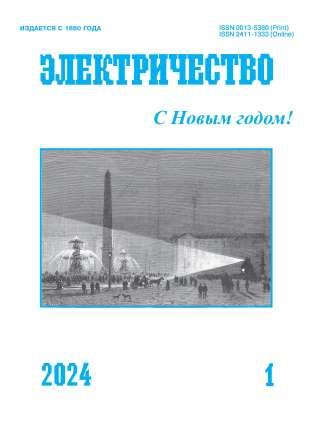Перспективы использования возобновляемых источников энергии в Ираке
DOI:
https://doi.org/10.24160/0013-5380-2024-1-63-68Ключевые слова:
фотоэлектрический модуль, солнечная энергия, PV-Wind, энергия ветра, гидроэнергетика, ИракАннотация
Статья посвящена исследованию существующих и будущих перспектив использования природных возобновляемых источников энергии в различных регионах Ирака. Географическая широта территории дает Ираку возможность использовать солнечную энергию. Ирак обладает одной из самых высоких плотностей солнечного излучения в мире. Вместе с тем, многие районы Ирака обладают огромным потенциалом ветроэнергетики. Южный регион подходит для реализации проектов по производству электроэнергии с помощью ветряных турбин, поскольку скорость ветра находится в допустимых пределах. В качестве одной из будущих энергосистем, основанных на возобновляемых ресурсах, для нескольких городов страны была предложена гибридная система "PV-Wind". Оптимальное использование экологически чистых энергетических ресурсов способствует развитию систем электроснабжения и сокращению времени перерывов питания в результате дефицита общего объема производства электроэнергии. Также это способствует сокращению выбросов углекислого газа, вызванных потреблением ископаемого топлива, что приносит пользу окружающей среде.
Библиографические ссылки
1. Al-Rubaye S.A., Price E.C. The Economic Impacts of Using Renewable Energy Technologies for Irrigation Water Pumping and Nanoparticle Fertilizers on Agri-Food Production in Iraq. – Sustainability, 2023, 15(6): 5478, DOI:10.3390/su15065478.
2. Елмстратов В.В. и др. Ресурсы и технологии использования возобновляемых источников энергии. СПб.: Политех-Пресс, 2022, 528 с.
3. Saleh N.M. et al. The Renewable, Sustainable, and Clean Energy in Iraq Between Reality and Ambition According to the Paris Agreement on Climate Change. – Mesopotamian Journal of Big Data, 2022, pp. 36–43, DOI:10.58496/MJBD/2022/005.
4. Hussain Z.S. et al. A Look at the Wind Energy Prospects in Iraq: Review. – International Conference on Engineering & MIS (ICEMIS), DOI: 10.1109/ICEMIS56295.2022.9914119.
5. Al-Yozbaky O.S.A.Y., Khalel S.I. The Future of Renewable Energy in Iraq: Potential and Challenges. – Indonesian Journal of Electrical Engineering and Informatics, 2022, vol. 10, No. 2, DOI: 10.52549/ijeei.v10i2.3756.
6. Renewable Energy and Jobs: Annual Review 2023. – IRENA and ILO, 2023, Abu Dhabi and International Labour Organization, Geneva, pp .18–24.
7. Mohammed H.J. et al. Study the Possibility of Application of Wind Turbine under the Climatic Conditions of Iraq. – Conference of Russian Young Researchers in Electrical and Electronic Engineering, 2022, DOI: 10.1109/ElConRus54750.2022.9755822.
8. Rashid K.A. Present and Future for Hydropower Developments in Kurdistan. – Energy Procedia, 2017, vol. 112, pp. 632–639, DOI: 10.1016/j.egypro.2017.03.1130.
9. Pilesjö P., Al-Juboori S.S. Modelling the Effects of Climate Change on Hydroelectric Power in Dokan, Iraq. – International Journal of Energy and Power Engineering, 2016, vol. 5 (2-1), pp: 7–12, DOI: 10.11648/j.ijepe.s.2016050201.12.
10. Ministry of Electricity of Iraq: Components of the Electrical System [Электрон. ресурс], URL: http://www.moelc.gov.iq/detailsarticle_ar.aspx?id=37/ (дата обращения 22.10.2023).
11. Kuznetsov N.P. et al. Investigation of the Losses of Photovoltaic Solar Systems During Operation under Partial Shading. – Journal of Applied Engineering Science, 2020, vol. 18, No. 3, pp. 313–320. DOI: 10.5937/jaes18-24460.
12. Istepanian H.H. Solar Energy in Iraq: From Outset to Offset, IEA, 2018, 21 p.
13. NASA Surface meteorology and Solar Energy: RETScreen Data [Электрон. ресурс], URL: https://eosweb.larc.nasa.gov (дата обращения 20.09.2023).
14. Al-Antaki A.M. et al. Control of hybrid DC/AC Microgrid System Employing Fuel Cell and Solar Photovoltaic Sources Using Grey Wolf Optimization, Clean Energy, 2022, 6(4), pp. 659–670, DOI:10.1093/ce/zkac046.
15. Global Solar Atlas, v. 2.9 [Электрон. ресурс], URL: https://globalsolaratlas.info/map (дата обращения 20.09.2023).
16. EWEA. Wind Energy – the Facts: a Guide to the Technology, Economics and Future of Wind Power, London: Earthscan, 2009, 568 p.
17. Korovkin N.V., Potienko A.A. The Use of a Genetic Algorithm for Solving Electric Engineering Problems. – Электричество, 2002, №. 11, с. 2–15.
#
1. Al-Rubaye S.A., Price E.C. The Economic Impacts of Using Renewable Energy Technologies for Irrigation Water Pumping and Nanoparticle Fertilizers on Agri-Food Production in Iraq. – Sustainability, 2023, 15(6): 5478, DOI:10.3390/su15065478.
2. Elistratov V.V. et al. Renewable Energy Resources and Application Technologies. SPb.: Polytech-Press, 2022, 528 p.
3. Saleh N.M. et al. The Renewable, Sustainable, and Clean Energy in Iraq Between Reality and Ambition According to the Paris Agreement on Climate Change. – Mesopotamian Journal of Big Data, 2022, pp. 36–43, DOI:10.58496/MJBD/2022/005.
4. Hussain Z.S. et al. A Look at the Wind Energy Prospects in Iraq: Review. – International Conference on Engineering & MIS (ICEMIS), DOI: 10.1109/ICEMIS56295.2022.9914119.
5. Al-Yozbaky O.S.A.Y., Khalel S.I. The Future of Renewable Energy in Iraq: Potential and Challenges. – Indonesian Journal of Electrical Engineering and Informatics, 2022, vol. 10, No. 2, DOI: 10.52549/ijeei.v10i2.3756.
6. Renewable Energy and Jobs: Annual Review 2023. – IRENA and ILO, 2023, Abu Dhabi and International Labour Organization, Geneva, pp .18–24.
7. Mohammed H.J. et al. Study the Possibility of Application of Wind Turbine under the Climatic Conditions of Iraq. – Conference of Russian Young Researchers in Electrical and Electronic Engineering, 2022, DOI: 10.1109/ElConRus54750.2022.9755822.
8. Rashid K.A. Present and Future for Hydropower Developments in Kurdistan. – Energy Procedia, 2017, vol. 112, pp. 632–639, DOI: 10.1016/j.egypro.2017.03.1130.
9. Pilesjö P., Al-Juboori S.S. Modelling the Effects of Climate Change on Hydroelectric Power in Dokan, Iraq. – International Journal of Energy and Power Engineering, 2016, vol. 5 (2-1), pp: 7–12, DOI: 10.11648/j.ijepe.s.2016050201.12.
10. Ministry of Electricity of Iraq: Components of the Electrical System [Electron. resource], URL: http://www.moelc.gov.iq/detailsarticle_ar.aspx?id=37/ (Date of appeal 22.10.2023).
11. Kuznetsov N.P. et al. Investigation of the Losses of Photovoltaic Solar Systems During Operation under Partial Shading. – Journal of Applied Engineering Science, 2020, vol. 18, No. 3, pp. 313–320. DOI: 10.5937/jaes18-24460.
12. Istepanian H.H. Solar Energy in Iraq: From Outset to Offset, IEA, 2018, 21 p.
13. NASA Surface meteorology and Solar Energy: RETScreen Data [Electron. resource], URL: https://eosweb.larc.nasa.gov (Date of appeal 20.09.2023).
14. Al-Antaki A.M. et al. Control of hybrid DC/AC Microgrid System Employing Fuel Cell and Solar Photovoltaic Sources Using Grey Wolf Optimization, Clean Energy, 2022, 6(4), pp. 659–670, DOI:10.1093/ce/zkac046.
15. Global Solar Atlas, v. 2.9 [Electron. resource], URL: https://globalsolaratlas.info/map (Date of appeal 20.09.2023).
16. EWEA. Wind Energy – the Facts: a Guide to the Technology, Economics and Future of Wind Power, London: Earthscan, 2009, 568 p.
17. Korovkin N.V., Potienko A.A. The Use of a Genetic Algorithm for Solving Electric Engineering Problems. – Elektrichestvo, 2002, No. 11, pp. 2–15.




